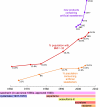Gain weight by "going diet?" Artificial sweeteners and the neurobiology of sugar cravings: Neuroscience 2010
- PMID: 20589192
- PMCID: PMC2892765
Gain weight by "going diet?" Artificial sweeteners and the neurobiology of sugar cravings: Neuroscience 2010
Abstract
America's obesity epidemic has gathered much media attention recently. A rise in the percent of the population who are obese coincides with an increase in the widespread use of non-caloric artificial sweeteners, such as aspartame (e.g., Diet Coke) and sucralose (e.g., Pepsi One), in food products (Figure 1). Both forward and reverse causalities have been proposed. While people often choose "diet" or "light" products to lose weight, research studies suggest that artificial sweeteners may contribute to weight gain. In this mini-review, inspired by a discussion with Dr. Dana Small at Yale's Neuroscience 2010 conference in April, I first examine the development of artificial sweeteners in a historic context. I then summarize the epidemiological and experimental evidence concerning their effects on weight. Finally, I attempt to explain those effects in light of the neurobiology of food reward.
Keywords: acesulfame K; artificial sweeteners; aspartame; food reward; neotame; non-caloric; obesity; postingestive effects; saccharin; sucralose; sugar; weight gain.
Figures


References
-
- Storey ML, Forshee RA, Anderson PA. Beverage consumption in the US population. J Am Diet Assoc. 2006;106:1992–2000. - PubMed
-
- Pedersen D. Alternative Sweeteners. Biotechnology and food ingredients. New York: Van Nostrand Reinhold; 1991.
-
- Kauffman GB, Priebe PM. The discovery of saccharin: a centennial retrospect. Ambix. 1978;25:191–207. - PubMed
-
- Cohen SM. Saccharin: past, present, and future. J Am Diet Assoc. 1986;86:929–931. - PubMed
Publication types
MeSH terms
Substances
LinkOut - more resources
Full Text Sources
Other Literature Sources
Medical
Miscellaneous
